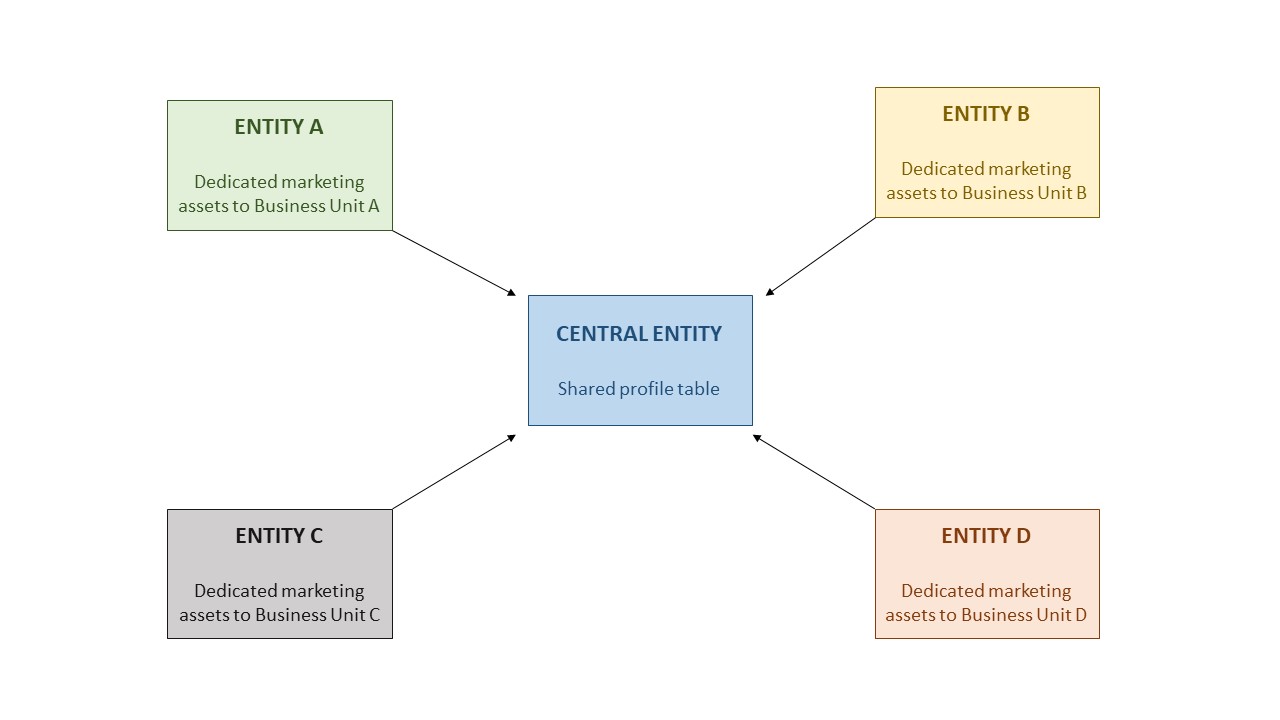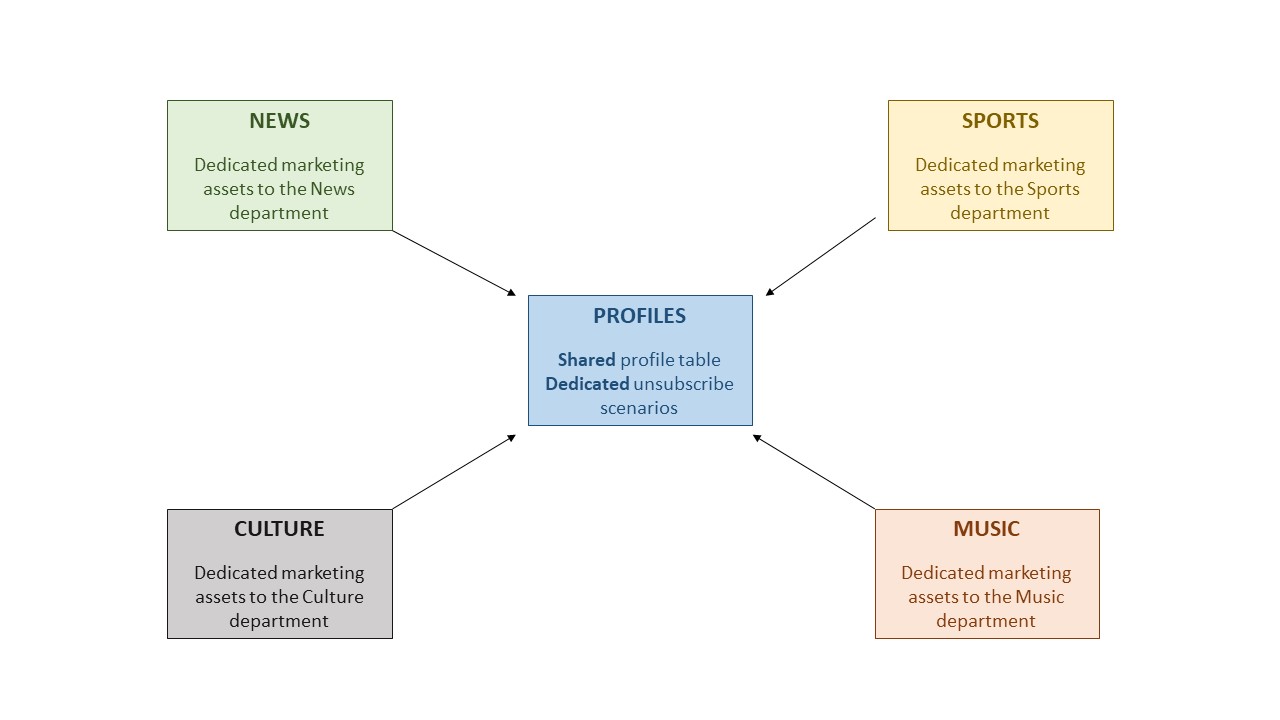Understanding business units
In certain cases, especially in the media industry, a unique profile table is shared by different business units/departments. The organisation of a licence with a central entity and its assets is particular. In this article, we’ll go through the organisation of the licence thanks to entities and user configurations, and of the assets. A concrete example is also provided to illustrate this use case.
The organisation
For these specific cases, the licence can be partitioned in different entities:
- One central entity, containing the shared profile table, to which all business units have access
- Several entities (A, B, C & D) revolving around this central entity

The entities revolving around the central entity are dedicated to a particular business unit. For example, Business Unit A uses Entity A. This dedicated entity contains marketing assets related to this particular business unit.
Using entity groups
Thanks to the use of entity groups, it is possible to give access to certain users to certain entities. Therefore, a person working in Business Unit A has access to the central entity (in order to have access to the shared profile table) and to its own entity (Entity A) but does not have access to entities from other business units. Similarly, a person working in Business Unit D has access to the central entity and to its own entity (Entity D) but does not have access to entities from other business units.
Using user configurations
On top of restraining the available entities with entity groups, it is possible to choose which modules the users will use in the entities they have access to. This is manageable through user configurations.
There exist six standard configurations available by default. To understand which modules are available for each of these different standard configurations, we invite you to consult this file: Standard Rights Configurations.xlsx
If you’d like to create a custom configuration, please contact your account manager.
The assets
In their own entity, each business unit has its own:
- Campaigns (email, SMS, push…) and related reporting
Reporting is specific to each entity. Users will only see the reports related to the campaigns that are sent in the entities they have access to.
- Scenarios
- Saved templates
- Custom tables
When creating your Interaction and Linked Data custom tables, you will have the opportunity to choose the profile table and the entity on which you want to host your tables. The entity does not necessarily have to be the same as the profile table's one. As your Repository tables are not linked to one profile table in particular, you will only have to choose the entity.
In the shared entity, each business unit shares the following assets with other business units:
The preference centers must be created on the table of profiles’ entity. Therefore, it is not possible not to share these preference centers on the shared entity (and therefore with other business units). More information about this topic is available in the dedicated article.
- Design templates
A good practice is to link the design templates to the shared entity in order not to have different versions of the same template in different entities.
- Saved targetings
Saved targetings have to be created on the table of profiles’ entity, as this entity will contain all the data on which the targetings will be created. These saved targetings can however be used in the campaigns created in dedicated entities.
Using saved templates
It is possible to create saved templates in each dedicated entity (A, B, C or D), based on a design template hosted on the shared entity. These saved targetings will be a declination of the design template.
The saved templates created in the dedicated entities will have their own graphical charter, and will enable to save campaign parameters such as the predefined targeting, sending domain, the commercial pressure, the targeting, the sender, the subject, the content, the personalisations… The saved templates created in the dedicated entities will have their own graphical charter, and will enable to save campaign parameters such as the predefined targeting, sending domain, the commercial pressure, the targeting, the sender, the subject, the content, the personalisations…
When using the template, the saved parameters will be prefilled, which enables to save time and avoid making mistakes or forgetting parameters.
The predefined targeting is very useful for targeting only the profiles that are relevant for a specific business unit. It will avoid sending a campaign to a wrong selection of profiles or to profiles that cannot legitimaly be contacted.
Predefined targeting and saved targeting do not have the same purpose. For more information, please check the documentation about predefined targeting.
Therefore, the predefined targeting to be found in the saved templates of Business Unit A will only target people that want to be contacted by the campaigns of Business Unit A.
The predefined targeting is very useful for targeting only the profiles that are relevant for a specific business unit. It will avoid sending a campaign to a wrong selection of profiles or to profiles that cannot legitimaly be contacted.
Predefined targeting and saved targeting do not have the same purpose. For more information, please check the documentation about predefined targeting.
Therefore, the predefined targeting to be found in the saved templates of Business Unit A will only target people that want to be contacted by the campaigns of Business Unit A.
Example
In order to illustrate this use case, let’s have a look at a concrete example. Imagine a company in the Media industry having four business units: News, Sports, Culture and Music.
The company has a common profile table, which contains the profiles of all business units. One profile can possibly want to receive campaigns from the News department as well as from the Music department, for example. This shared profile table is located on an entity named Profiles.
The user accesses to the different entities are created as follows…
- A person working in the News department has access to the entity Profiles and News
- A person working in the Sports department has access to the entity Profiles and Sports
- A person working in the Culture department has access to the entity Profiles and Culture
- A person working in the Music department has access to the entity Profiles and Music

… thanks to the entity groups.

Within these entity groups, users working in the same department (ex: News) can have different user configurations:
- A person can have the access Advanced User, because I want him to be able to do everything except managing other users
- Another person can have the access Restricted User because I don’t want him to be able to manage profiles (and therefore to have access to the profile table), but I want him to define campaigns

Each business unit has its own marketing assets, with its own graphical charter. Therefore, all campaigns, scenarios, and saved templates are created on their own entity.
For example, a marketer from the News business unit will create its campaigns on the News entity with a saved template that will contain the following saved parameters:
- A predefined targeting that limits the target to the profiles who want to receive campaigns related to the News business unit
- A predefined targeting that limits the target to the profiles who want to receive campaigns related to the News business unit
- A sender related to their department (ex: Journal)
- A sending domain dedicated to the News department
- A saved targeting that targets only profiles between 40 and 60 years old (among the predefined targeting)
- A saved targeting that targets only profiles between 40 and 60 years old (among the predefined targeting)
- Content respecting the graphical charter of the News department
Preference centers that will later be linked to an unsubscribe scenario are created on the shared entity, namely Profiles. However, each business unit will have the opportunity to choose its own unsubscribe scenario when creating a campaign. For more information about this subject, please read this article.